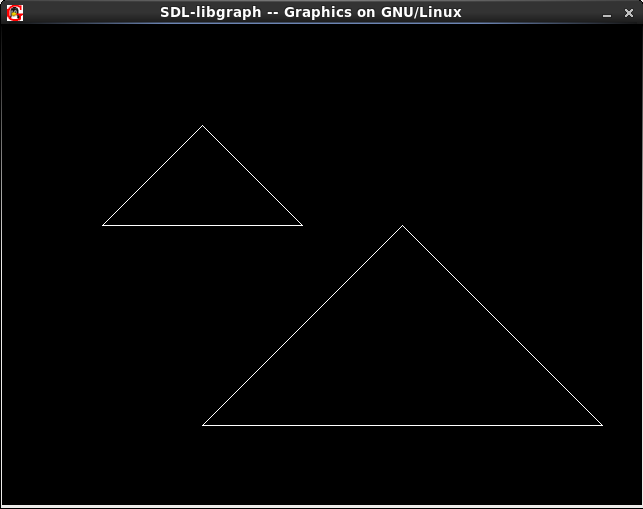缩放变换会更改对象的大小。在缩放过程中, 我们压缩或扩展对象的尺寸。
缩放操作可以通过缩放因子sx和sy将多边形的每个顶点坐标(x, y)相乘得到变换后的坐标为(x ', y ')。
分别沿X和Y方向缩放对象。因此, 以上等式可以用矩阵形式表示:

或P'= S.P
缩放过程:

注意:
如果缩放因子S小于1, 则我们减小对象的大小。如果比例因子S大于1, 则我们将增加对象的大小。
算法:
1. Make a 2x2 scaling matrix S as:
Sx 0
0 Sy
2. For each point of the polygon.
(i) Make a 2x1 matrix P, where P[0][0] equals
to x coordinate of the point and P[1][0]
equals to y coordinate of the point.
(ii) Multiply scaling matrix S with point
matrix P to get the new coordinate.
3. Draw the polygon using new coordinates.下面是C的实现:
// C program to demonstrate scaling of abjects
#include<stdio.h>
#include<graphics.h>
// Matrix Multiplication to find new Coordinates.
// s[][] is scaling matrix. p[][] is to store
// points that needs to be scaled.
// p[0][0] is x coordinate of point.
// p[1][0] is y coordinate of given point.
void findNewCoordinate( int s[][2], int p[][1])
{
int temp[2][1] = { 0 };
for ( int i = 0; i < 2; i++)
for ( int j = 0; j < 1; j++)
for ( int k = 0; k < 2; k++)
temp[i][j] += (s[i][k] * p[k][j]);
p[0][0] = temp[0][0];
p[1][0] = temp[1][0];
}
// Scaling the Polygon
void scale( int x[], int y[], int sx, int sy)
{
// Triangle before Scaling
line(x[0], y[0], x[1], y[1]);
line(x[1], y[1], x[2], y[2]);
line(x[2], y[2], x[0], y[0]);
// Initializing the Scaling Matrix.
int s[2][2] = { sx, 0, 0, sy };
int p[2][1];
// Scaling the triangle
for ( int i = 0; i < 3; i++)
{
p[0][0] = x[i];
p[1][0] = y[i];
findNewCoordinate(s, p);
x[i] = p[0][0];
y[i] = p[1][0];
}
// Triangle after Scaling
line(x[0], y[0], x[1], y[1]);
line(x[1], y[1], x[2], y[2]);
line(x[2], y[2], x[0], y[0]);
}
// Driven Program
int main()
{
int x[] = { 100, 200, 300 };
int y[] = { 200, 100, 200 };
int sx = 2, sy = 2;
int gd, gm;
detectgraph(&gd, &gm);
initgraph(&gd, &gm, " " );
scale(x, y, sx, sy);
getch();
return 0;
}输出如下:

如果发现任何不正确的地方, 或者想分享有关上述主题的更多信息, 请写评论。

![从字法上最小长度N的排列,使得对于正好为K个索引,a[i] a[i]+1](https://www.lsbin.com/wp-content/themes/begin%20lts/img/loading.png)